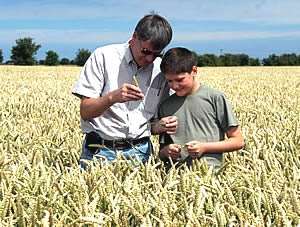Phil Needham spoke at the SouthWest Agriculture Conference
By Diego Flammini
Assistant Editor, North American Content
Farms.com
According to Phil Needham, owner of Needham Ag Technologies, one of the keys to high-yielding wheat is uniformity during planting.
During the SouthWest Agriculture Conference at the University of Guelph’s Ridgetown Campus, Needham said of all the possible weak links, uniformity is among the most important factor. He suggested farmers begin treating wheat the same way they treat other crops.

Phil Needham, left, with his son, standing in a wheat field.
“To achieve high wheat yields without spending more, farmers have to look at wheat the same way they look at corn,” he said during his presentation. “(They) have to get seeds to a consistent depth.”
Needham said uniformity starts with seedbed preparation. This work begins at harvest time with residue management.
“If you don’t do a good job spreading reside, you risk getting sub-par performance out of seeding equipment.”
And when it comes to yield, Needham said there are four components:
- The number of heads per square meter – Needham suggested wheat fields need upwards of 600 heads per square meter.
- The number of spikelets per head – Needham said anywhere between 12 and 15 spikelets per head can result in a good yield.
- The number of grains per spikelet – Two to four per grains per spikelet, according to Needham.
- The weight of each grain.